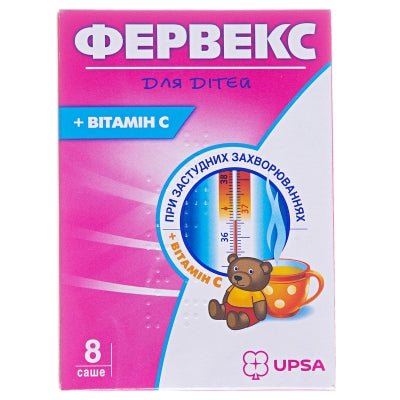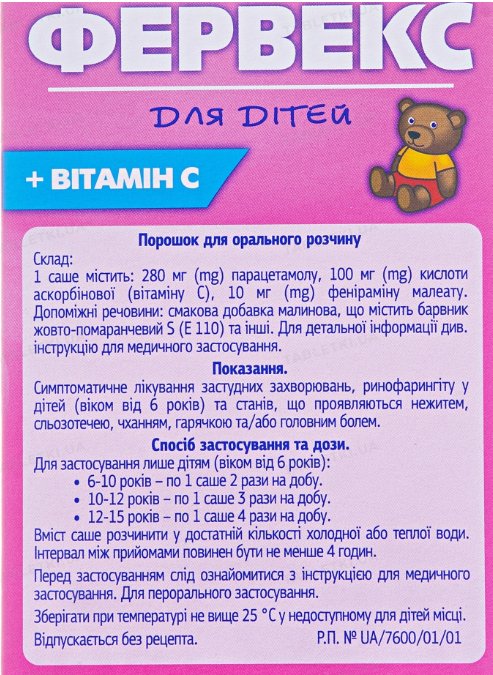Please double-check your email address when placing an order. A correct email ensures you receive shipping updates and don’t miss your package.
If you don’t see our emails, check your Spam folder.
Fervex for children from 6 years old 8 sachets
⛟ Same day shipping
❤ Free US shipping on Orders $59+
☎ Can’t find it? Ask us via WhatsApp, phone or chat
💰Bonus program
If this product is temporarily out of stock, consider: Fervex lemon with sugar 8 sachets
Composition
Active ingredients: paracetamol, ascorbic acid (vitamin C), pheniramine maleate;
1 sachet contains: paracetamol 280 mg, ascorbic acid (vitamin C) 100 mg, pheniramine maleate 10 mg;
excipients: mannitol (E 421), citric acid anhydrous, povidone, trimagnesium dicitrate anhydrous, potassium acesulfame, raspberry flavoring containing sunset yellow FCF (E 110).
Dosage form
Powder for oral solution.
Main physical and chemical properties:
Granulated powder ranging from light pink to dark pink, with possible small dark particles.
Indications
Symptomatic treatment of colds, nasopharyngitis in children (aged 6 years and older), and conditions accompanied by a runny nose, tearing, sneezing, fever, and/or headache.
Contraindications
Hypersensitivity to the components of the product or other antihistamines, severe liver and/or kidney dysfunction, phenylketonuria, congenital hyperbilirubinemia, glucose-6-phosphate dehydrogenase deficiency, alcoholism, blood disorders, severe anemia, leukopenia, severe arterial hypertension, unstable angina; severe cardiac conduction disorders, acute myocardial infarction, severe atherosclerosis, uncompensated heart failure, hyperthyroidism, acute urinary retention due to prostatic hypertrophy, bladder neck obstruction, pyloroduodenal obstruction, gastric and duodenal ulcers in the acute stage, closed-angle glaucoma, thrombosis, thrombophlebitis, epilepsy, severe forms of diabetes mellitus.
Do not use in combination with MAO inhibitors or within two weeks after stopping them. Contraindicated in patients taking tricyclic antidepressants or beta-blockers. Urolithiasis when ascorbic acid is consumed in doses exceeding 1 g per day. Children under 6 years of age.
*We apologize for any inconvenience in case of the product being out of stock.
Please feel free to use this form to contact us, and we will notify you as soon as the item is available again.
Here's something that might pique your interest:
Immunomodulators and Antiviral Products: Specialized Solutions for Flu and Cold
In our blog, you can discover a wealth of fascinating and valuable information.
Thank you for choosing USA Apteka, your Russian pharmacy and trusted source for popular, favorite OTC products from Russia, Ukraine, and other CIS countries.
Important
Use
Warnings
Please Chat with us or send us a message on WhatsApp








